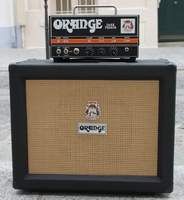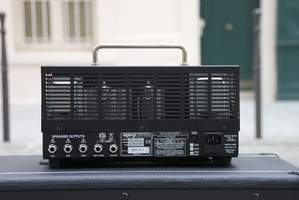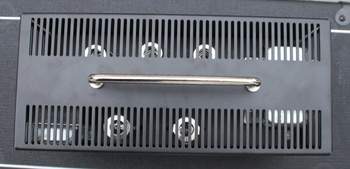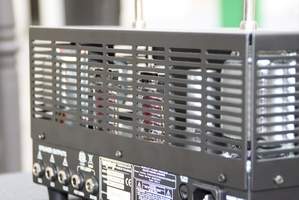At AudioFanzine, we are acutely aware of all the small terrors unleashed by Orange. We already reviewed the Tiny Terror (the first model), the Dual Terror (two channels) and the Bass Terror (four-string player version) — now comes the Dark Terror.
This time, the orange ripened in a cellar and didn’t see the light of day for a long time — the orange is very sour. Behind its black look, the design is based on the Tiny Terror with a metal housing and three controls. It also has the same features: a 15 watts power stage and only one single channel.
But, apart from the color, where is the difference with the Tiny Terror?
We will come back to this later, but let’s have a look at the product first…
Black is Black
No need for a detailed hardware description: everybody knows what it’s all about. It still looks very rough, the small gig bag with the Orange logo is also there and we were lucky enough to get an Orange speaker cabinet with the same dark finish. The latter uses a standard 12" Celestion Vintage 30 speaker. The speaker cabinet weights about 44 lbs and has the following dimensions: 20.5" × 17.7" × 11.8". The amplifier head weights 15.4 lbs, versus the 11 lbs of the Tiny Terror (is black paint 4 lbs. heavier than white pain?). The dimensions are compact enough (11.8" × 6.7" × 5.5") to allow an easy transportation in the subway, on a hot-air balloon or on foot.
The front panel is not surprising and it features the exact same controls as the Tiny Terror: Guitar input, On/Off and 15 Watts/Standby/7 Watts switches, a nice red lamp indicating the unit is on, and the three controls for Volume, Shape and Gain. As you might have noticed, the EQ section still includes only one single control. And we will see below that this is not necessarily a disadvantage…
The rear panel allows you to connect:
(1) 16 Ohm cab into the (1) 16 Ohm output
(2) 16 Ohm cabs into the (2) 8 Ohm outputs
(1) 8 Ohm cab into one of the 8 Ohm outputs
Orange had the brilliant idea of adding an FX loop (with a 12AT tube), which was dearly missed on the Tiny Terror.
Under the hood you’ll find not two, but three 12AX7 tubes in the preamp stage. This is the main difference with the Tiny Terror, which uses only two preamp tubes. On the other hand, the power amp stage with a couple of EL84 tubes is exactly the same in both amps. Orange doesn’t provide more information in this respect. So, let’s have confidence in our ears!
Ocean of Darkness!
The goal of the Dark Terror is simple: to be more nasty and to offer more gain than the Tiny Terror. So yes, his head is designed for hard rock and heavy metal fans. You’ve been warned! For the sound samples, we placed two different mics in front of the speaker: a Sennheiser e906 and a Shure SM57. The first one is panned to the left channel and the second one to the right channel of the stereo files.
But, since we are very curious at AudioFanzine, we also played the amp clean with a Stratocaster. The result sounds a bit dull — clean sounds are not a highlight of the amp. And to be honest, we were expecting just that!

In use, the amp and the few but effective controls proved very pleasant. We specially liked the Shape control that allows you to go from rock to metal very easily. The more you turn the control to the left, the more the sound gets more hollow with the typical heavy metal boosted highs and lows. On the other hand, when you turn the control to the right, the mid frequency range is emphasized and the tone gets a more bluesy/rock character. Nobody should have a problem finding what’s right for him! To give you an idea of this powerful control, we played the same part and changed only the Shape setting with an Ibanez RG and a Gibson Les Paul. With the latter, we also changed the position of the gain control. The position of each control is given in the file name.

- Ibanez RG00:18
- Ibanez RG00:18
- Ibanez RG00:18
- Ibanez RG00:18
- Ibanez RG00:18
- Ibanez RG00:18
- Ibanez RG00:18
- Les Paul00:24
- Les Paul00:23
- Les Paul00:24
- Les Paul00:24
- Les Paul00:24
- Les Paul00:23
- Les Paul00:24
- Les Paul00:24
- Les Paul00:24
- Les Paul00:23
We also tried out the amp with guitars that are not considered metal axes (Gretsch, Telecaster, Rickenbaker), with a 335, an SG Classic (with two P90 pickups) and an ESP Kirk Hammet with active pickups. The results are sometimes exciting, especially with the Telecaster.

- Gretsch White Falcon00:22
- Telecaster00:21
- Telecaster00:21
- Telecaster00:21
- Rickenbaker00:22
- 33500:23
- SG Classic00:22
- SG Classic00:22
- ESP00:19
The gain amount can be quite high, more than enough to play heavy metal. Like the Tiny Terror, the difference between the 7 and 15 watt modes is subtle (listen to the SG Classic sound samples). The output power is enough to start a war with your neighbors and playing in a club with a drummer should be possible too. Like its brother, the Dark Terror works very well with stompboxes (even considering that you won’t need distortion pedals!). Also notice that we got crunch and overdrive sounds as well, and even clean sounds when turning down the volume on the guitar. Even if it’s not the main asset of this amp, this shows that it can be of use for music genres other than heavy metal. Moreover, the gain control interacts with the Shape control so the number of variations is almost endless. And of course, your favorite setting will depend on your guitar and taste! However, it’s important to mention that the sound always keeps a slight vintage character, even with extreme settings. Musicians who want a really modern tone might not like the Tiny Terror…
Finally, the lack of reverb is a drawback, but the FX loop is a big plus (there is no FX loop on the Tiny Terror).
Conclusion
With the Dark Terror, Orange offers us a more nasty Tiny Terror for fans of dirty and dark music. The head has the same assets as its older brother: sturdiness, ease of use, gig bag, and a hard rock/metal ready sound. We really liked the Shape control and the fact that we had enough gain to get very a fat tone. Musicians who love clean sounds shouldn’t bother trying this amp out — we even ask ourselves why on earth have they read this review up to here! For all others, the price is somewhat high ($650 for the head plus $380 for the speaker cabinet) but true love doesn’t know any limits…





